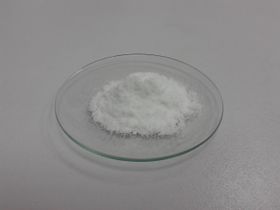Difference between revisions of "Sodium nitrite"
(→Preparation) |
|||
| Line 206: | Line 206: | ||
[[Category:Oxidizing agents]] | [[Category:Oxidizing agents]] | ||
[[Category:Materials unstable in acidic solution]] | [[Category:Materials unstable in acidic solution]] | ||
| + | [[Category:Essential reagents]] | ||
Latest revision as of 14:53, 18 November 2023
 Sodium nitrite sample on a watch glass.
| |
| Names | |
|---|---|
| IUPAC name
Sodium nitrite
| |
| Other names
Nitrous acid, sodium salt
| |
| Identifiers | |
| Jmol-3D images | Image |
| |
| Properties | |
| NaNO2 | |
| Molar mass | 68.9953 g/mol |
| Appearance | White or slight yellowish solid |
| Odor | Odorless |
| Density | 2.168 g/cm3 |
| Melting point | 271 °C (520 °F; 544 K) |
| Boiling point | 320 °C (608 °F; 593 K) (decomposes) |
| 71.4 g/100 mL (0 °C) 84.8 g/100 mL (25 °C) 160 g/100 mL (100 °C) | |
| Solubility | Very soluble in anhydrous ammonia Soluble in ethanol |
| Solubility in ethanol | 3 g/100 ml |
| Solubility in methanol | 4.4 g/100 ml |
| Solubility in diethyl ether | 0.3 g/100 mL |
| Acidity (pKa) | ~9 |
| Thermochemistry | |
| Std molar
entropy (S |
106 J·mol-1·K-1 |
| Std enthalpy of
formation (ΔfH |
−359 kJ/mol |
| Hazards | |
| Safety data sheet | ScienceCompany |
| Lethal dose or concentration (LD, LC): | |
| LD50 (Median dose)
|
180 mg/kg (rats, oral) |
| Related compounds | |
| Related compounds
|
Lithium nitrite Potassium nitrite Rubidium nitrite Caesium nitrite |
| Except where otherwise noted, data are given for materials in their standard state (at 25 °C [77 °F], 100 kPa). | |
| Infobox references | |
Sodium nitrite is the inorganic compound, the nitrate salt of nitrous acid with the chemical formula NaNO2.
Contents
Properties
Chemical
Sodium nitrite will react with sodium chloroacetate in aqueous solution to give nitromethane:[1]
- NaNO2 + ClCH2COONa + H2O → CH3NO2 + NaCl + NaHCO3
Sodium nitrite is a poor oxidizing agent, compared to its nitrate cousin.
Physical
Sodium nitrite is a white or white-yellowish hygroscopic solid, soluble in water and slightly soluble in primary alcohols, while insoluble in alkanes and chlorocarbons. It has a density of 2.168 g/cm3. It melts when heated to 271 °C, and will also decompose, with significant decomposition starting above 320 °C.
Availability
Sodium nitrite can be found as food additive. It is usually dyed pink to differentiate it from table salt. The dye can be removed by washing it with a solvent and further purification can be achieved by recrystallizing the sodium nitrite.
Preparation
There are many ways to prepare sodium nitrite.
A known process involves the reduction of sodium nitrate with metallic lead. About 8.5 g of powdered NaNO3 is mixed with 21 g of lead and heated until it melts. The mixture is kept liquid and stirred/agitated for 30-45 minutes until all the lead is oxidized to lead(II) oxide and forming sodium nitrite.
- NaNO3 + Pb → NaNO2 + PbO
The resulting slag is grounded and the sodium nitrite is purified by recrystallizing it from water. This procedure has the disadvantage of contaminating the product with lead oxide, making it less safe to handle without proper protection. It is also temperature sensitive.
The thermal reduction of sodium nitrate with calcium sulfite will also yield sodium nitrite.[2]
- NaNO3 + CaSO3 → NaNO2 + CaSO4
Calcium sulfamate can also be used.
Another method involves heating sodium nitrite with carbon in the presence of sodium hydroxide or calcium hydroxide.
- 2 NaNO3 + 2 NaOH + C → 2 NaNO2 + Na2CO3 + H2O
- 2 NaNO3 + Ca(OH)2 + C → 2 NaNO2 + CaCO3 + H2O
The latter method is preferred as calcium carbonate is insoluble in water and can be easily removed from the slag.[3]
A mixture of aluminium powder and sodium nitrate heated for 40 minutes will yield sodium nitrite.
The industrial route involves treating an aqueous solution of sodium hydroxide with a mixture of nitrogen dioxide and nitric oxide:
- 2 NaOH + NO2 + NO → 2 NaNO2 + H2O
This reaction is air-sensitive and traces of oxygen will lead to sodium nitrate.
Very pure sodium nitrite can be obtained by reacting nitrous acid (which can be obtained by adding dinitrogen trioxide to pure water) with sodium hydroxide.
- 2 NaOH + N2O3 → 2 NaNO2 + H2O
An interesting method involves reducing sodium nitrate using starch and sodium hydroxide.[4]
Projects
- Make alkyl nitrites
- Make nitromethane
- Destroy azides
- Make azo compounds
- Electrochemical grinding
- Meat curing
- Intravenous mixture of sodium nitrite and sodium thiosulfate can be used as antidote for cyanide poisoning.
Handling
Safety
Sodium nitrite is harmful if inhaled or ingested and proper protection should be worn when handling the compound.
Storage
Sodium nitrite should be kept in closed bottles, away from light, moisture and oxygen-rich environment.
Disposal
Heating sodium nitrite above 300 °C will cause it to decompose, leaving behind sodium oxide/hydroxide which can be safely disposed of.
Adding sodium percarbonate to sodium nitrite will convert it to sodium nitrate.
References
- ↑ http://www.orgsyn.org/demo.aspx?prep=CV1P0401
- ↑ https://www.google.com/patents/US670021
- ↑ http://www.google.com/patents/US792515
- ↑ http://www.sciencemadness.org/talk/viewthread.php?tid=52&page=10#pid493212
Relevant Sciencemadness threads
- Chemical pages without CAS Registry Number
- Articles without EBI source
- Chemical pages without ChemSpiderID
- Chemical pages without DrugBank identifier
- Articles without KEGG source
- Articles without InChI source
- Articles without UNII source
- Articles containing unverified chemical infoboxes
- Chemical compounds
- Inorganic compounds
- Sodium compounds
- Nitrites
- Oxidizing agents
- Materials unstable in acidic solution
- Essential reagents